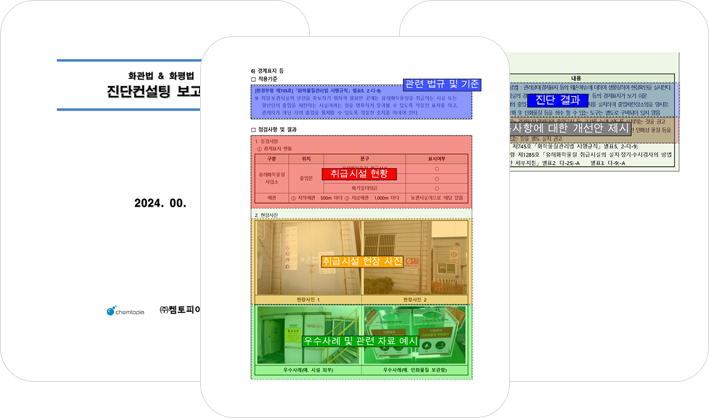Safety Diagnosis We diagnose compliance with legal and administrative standards
as well as risk factors for facilities handling hazardous chemicals to
present improvement and management plans along with a safety diagnosis report.
Safety Diagnosis
- K-REACH
- K-BPR compliance
- Diagnosis of workplaces under CCA
- Chemical management IT solution
Overview
In accordance with Article 24 of the Chemical Substances Control Act, a business establishment that installs and operates facilities for handling hazardous chemicals must undergo a safety inspection from an inspection agency and submit a safety inspection report if the period specified by the Ministry of Environment decree for each facility has passed. (Submission period for each facility: every 4 years (Risk A), 8 years (Risk B), and 12 years (Risk C) from the date of receipt of the review report of the chemical accident prevention management plan.)
| Category | Inspection cycle | |
|---|---|---|
| When installation/periodic inspection reveals a safety hazard concern | Within 20 days of receiving inspection results | |
| Risk level | Risk A | 4 years |
| Risk B | 8 years | |
| Risk C | 12 years | |
| Common (Risk A, B, C) | within 60 days of the expiration date | |
Chemtopia diagnoses the compliance with legal and administrative standards and risk factors for facilities handling hazardous chemicals and provides improvement and management plans along with a safety diagnosis report.
Our services
To help workplaces prepare for periodic inspections after 2020,
we provide consulting for safety management and compliance with laws
and regulations by identifying deficiencies and improvements
(including best practices) through diagnostic consulting
for facilities handling hazardous chemicals.

| Classification | Description | |
|---|---|---|
| Risk of handling substances | (1) Identification of the risk in handling hazardous chemicals. | |
| Handling process risk | Process safety | (1) Neutralization/disaster control - Check management status of absorption, neutralization, transfer equipment, etc. |
| (2) Safety valves and rupture disks - Periodic inspections and maintenance checks |
||
| (3) Flare stack, vent stack - Inspection and maintenance status checks |
||
| (4) Emergency shutoff - Inspection and maintenance status checks |
||
| (5) Interlock - Check operational management status such as bypass management |
||
| (6) Operation monitoring system - Inspection and maintenance status checks |
||
| (7) Emergency transport equipment - Inspection and maintenance status checks |
||
| (8) Other safety devices to prevent accidents | ||
| Electrical and instrumentation | (1) Check chemical leak detection alarm systems - Check the number of leak detection alarm systems, installation locations, operational tests, etc. |
|
| 2) Check instrumentation and control equipment - Check the management status of loop and automatic control systems including the control system on the spot, and check the inspection and maintenance status of various instruments |
||
| (3) Static elimination and grounding - Check bonding for each device, looping ground and maintaining proper resistance values |
||
| (4) Explosion-proof equipment - Check appropriate explosion-proof equipment and its |
||
| (5) Emergency power - Check electrical single line diagrams, connections, and maintenance status. |
||
| Risk of handling equipment | (1) Fixed equipment such as containers and storage facilities - Check thickness, hardness, internal and external corrosion conditions, non-destructive testing, etc. |
|
| (2) Plumbing - Verification of thickness, hardness, internal and external corrosion conditions, heat and cold storage conditions, non-destructive testing, and design of major piping, including proper expansion joints, loops, supports, etc. |
||
| (3) Rotating equipment, such as power machinery - Check vibration and maintenance status. |
||
| Risk of handling methods | Operating method | (1) Check the appropriateness of operating manuals - Ensure that the operating manual includes all safety principles in a systematic and easy-to-understand manner for each case, such as plant startup, shutdown, and emergency shutdown. |
| Emergency response | (1) Verification of emergency measures - Ensure that the necessary measures and detailed procedures are in place for safety in the event of an emergency, such as a fire, explosion, or hazardous chemical spill. |
|
| Maintenance | (1) Verification of facility maintenance guidelines, etc. - Establish guidelines and procedures for the maintenance of facilities and check the implementation of inspection plans and improvement measures after inspection. (2) Verification of compliance with safety work permits and work procedures - Verify compliance with required work procedures and safety precautions for hazardous tasks such as working with fire, entering confined spaces, etc. |
|
| Visual inspection | (1) Installation and periodic inspection items under Article 7 (2) Perform visual diagnostics to check for cracks, global corrosion, localized corrosion, etc. |
|
| Other fields | Check maintenance and appropriateness for each item. | |
Workflow

